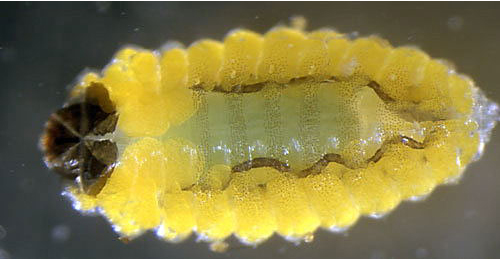|
||||||
|
Rhamphus
pulicarius (Herbst, 1795) Curculio
pulicarius
Herbst, 1795 |
||||||||||||||||||||||||||||||||||||||||||||||||||
Leaf-miner: Generally small, upper-surface, pear-shaped mines, half of their surface stuffed with frass. In the frass-free part an oval, flattened larva. Often several mines in a leaf. Prior to oviposition the larvae eat, a large number of tiny holes in the leaves (Bladmineerders van Europa). The larva over winters in the upper surface mine. There can be several mines in a leaf (British leafminers).
Larva: The larvae of beetles have a head capsule and chewing mouthparts with opposable mandibles and lack abdominal legs (see examples). The larva is illustrated in Bladmineerders van Europa.
Pupa: The pupae of beetles have visible head appendages, wings and legs which lie in sheaths (see examples). Hosts in Great Britain and Ireland:
Hosts elsewhere: Time of year - larvae: August - October (British leafminers). Time of year - adults: Currently unknown. Distribution in Great Britain and Ireland: Widespread in Britain including Anglesey, Bedfordshire, Breconshire, Caernarvonshire, Cambridgeshire, Cardiganshire, Carmarthenshire, Cheshire, Cumberland, Denbighshire, Dorset, Dumfriesshire, East Kent, East Norfolk, East Ross, East Suffolk, East Sussex, Easterness, Glamorgan, Huntingdonshire, Leicestershire, Merionethshire, Monmouthshire, Montgomeryshire, North Ebudes, Northamptonshire, Nottinghamshire, Pembrokeshire, Radnorshire, Shropshire, South Hampshire, South Lancashire, South Lincolnshire, South Northumberland, South Somerset, South-west Yorkshire, Stafford, Surrey, Warwickshire, West Cornwall, West Gloucestershire West Lancashire, West Norfolk, West Ross, West Suffolk, West Sussex, Westerness and Westmorland and Worcestershire (NBN Atlas) Also recorded in the Republic of Ireland and Northern Ireland (Fauna Europaea) and in Ireland (InvertebrateIreland Online). Distribution elsewhere: Widespread in continental Europe including Bulgaria, Corsica, French mainland, Germany, Greek mainland, Hungary, Italian mainland, Moldova, Poland, Romania, Russia - East, Sardinia, Sicily, Slovakia and Yugoslavia. Also recorded in the East Palaearctic and North Africa (Fauna Europaea). NBN Atlas links to known host species: British and Irish Parasitoids in Britain and elsewhere: Currently unknown. |
|
|
|
| External links: | Search the internet: |
|
Biodiversity Heritage Library |
Find
using Google Find using Google Scholar Find images using Google |
| Last updated 08-Jul-2019 Brian Pitkin | ||

